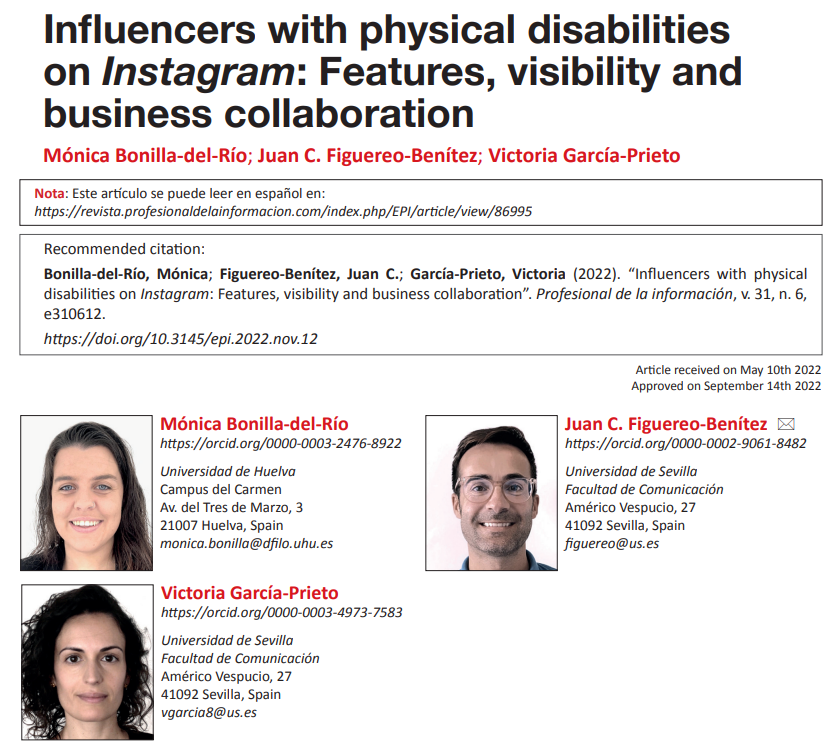
Influencers with physical disabilities on Instagram: Features, visibility and business collaboration
On Sale
€15.00
€15.00
Abstract: In the digital world, social media have become important for people with disabilities in terms of communication and visibility. They have also become the ideal place for activism, as they allow the self-representation of disability by the content creators themselves. This social group, traditionally segregated and discriminated against, has seen in these platforms a tool to promote social inclusion and confront the dominant discourse. This paper explores the social media Instagram as a space for communication and visibility of instagrammers with disabilities from Europe and Latin America. The main objective of the research is to analyse the publications of Spanish-speaking influencers with physical disabilities to establish if there are similar characteristics or if there are significant differences in the uses they make of Instagram’s functions and how disability is represented in their profiles. Through quantitative, descriptive, and statistical research, a content analysis was carried out of 400 publications corresponding to 10 Instagram profiles, all of them of microinfluencers and macroinfluencers with physical disabilities who had different types of business collaborations. The results show that disability is visible in 85% of the publications, whether in the photos or videos shared, in the text of the post, hashtags or emoticons, although it predominates to a greater extent in audiovisual content. In advertising, mentions or tags of brands stand out, much more than paid collaboration, which appears as a minority compared to other forms of promotion. The degree of influence is decisive for interactions in the form of likes and views per video or reels. Finally, the use of hashtags on inclusion and social awareness reinforces the importance of these platforms for the social integration of people with disabilities.
Resumen: En el mundo digital las redes sociales adquieren importancia para las personas con discapacidad en términos de comunicación y visibilidad. Asimismo, se han convertido en el lugar idóneo para el activismo, ya que permiten la autorrepresentación de la discapacidad por los propios creadores de contenido. Este grupo social, tradicionalmente aislado y discriminado, ha visto en estas plataformas una vía para fomentar la inclusión social y hacer frente al discurso dominante. Este trabajo explora la red social Instagram como espacio de comunicación y de visibilidad de instagrammers con discapacidad de Europa y Latinoamérica. El objetivo principal de la investigación es analizar las publicaciones de influencers hispanohablantes con discapacidad física para establecer si se dan unas características similares o si existen diferencias significativas en los usos que hacen de las funcionalidades de Instagram y cómo se ve representada la discapacidad en sus perfiles. Mediante una investigación cuantitativa, descriptiva y estadística, se realizó un análisis de contenido de 400 publicaciones correspondientes a 10 perfiles de Instagram, todos ellos de microinfluencers y macroinfluencers con discapacidad física que contaban con colaboraciones empresariales de diverso tipo. Los resultados muestran que la discapacidad es visible en un 85% de las publicaciones, ya sea en las fotografías o vídeos compartidos, en el texto del post, los hashtags o los emoticonos, aunque predomina en mayor medida en el contenido audiovisual. En la publicidad destacan las menciones o etiquetas a marcas, muy por encima de la colaboración pagada, que aparece minoritariamente en comparación con otras formas de promoción. El grado de influencia se muestra determinante para las interacciones en forma de likes y reproducciones por vídeo o reels. Por último, el uso de hashtags sobre inclusión y concienciación social refuerza la importancia de estas plataformas en la integración social de las personas con discapacidad.
Resumen: En el mundo digital las redes sociales adquieren importancia para las personas con discapacidad en términos de comunicación y visibilidad. Asimismo, se han convertido en el lugar idóneo para el activismo, ya que permiten la autorrepresentación de la discapacidad por los propios creadores de contenido. Este grupo social, tradicionalmente aislado y discriminado, ha visto en estas plataformas una vía para fomentar la inclusión social y hacer frente al discurso dominante. Este trabajo explora la red social Instagram como espacio de comunicación y de visibilidad de instagrammers con discapacidad de Europa y Latinoamérica. El objetivo principal de la investigación es analizar las publicaciones de influencers hispanohablantes con discapacidad física para establecer si se dan unas características similares o si existen diferencias significativas en los usos que hacen de las funcionalidades de Instagram y cómo se ve representada la discapacidad en sus perfiles. Mediante una investigación cuantitativa, descriptiva y estadística, se realizó un análisis de contenido de 400 publicaciones correspondientes a 10 perfiles de Instagram, todos ellos de microinfluencers y macroinfluencers con discapacidad física que contaban con colaboraciones empresariales de diverso tipo. Los resultados muestran que la discapacidad es visible en un 85% de las publicaciones, ya sea en las fotografías o vídeos compartidos, en el texto del post, los hashtags o los emoticonos, aunque predomina en mayor medida en el contenido audiovisual. En la publicidad destacan las menciones o etiquetas a marcas, muy por encima de la colaboración pagada, que aparece minoritariamente en comparación con otras formas de promoción. El grado de influencia se muestra determinante para las interacciones en forma de likes y reproducciones por vídeo o reels. Por último, el uso de hashtags sobre inclusión y concienciación social refuerza la importancia de estas plataformas en la integración social de las personas con discapacidad.
